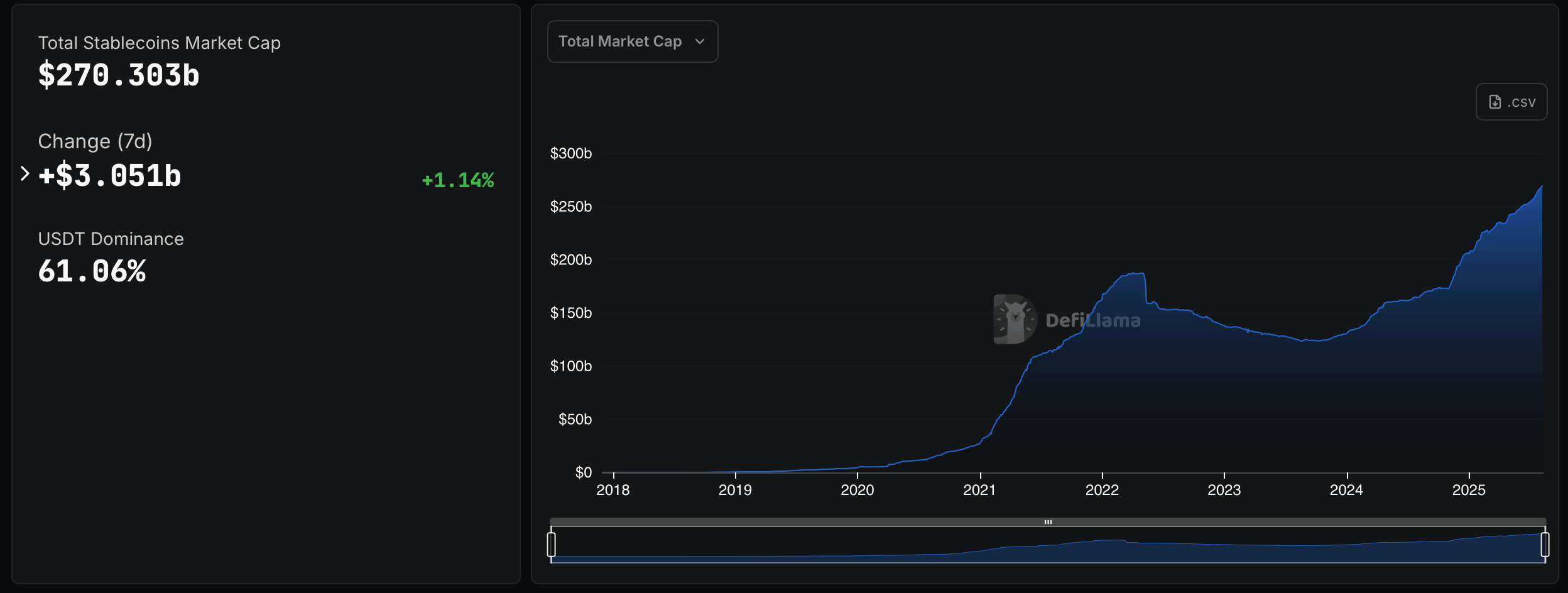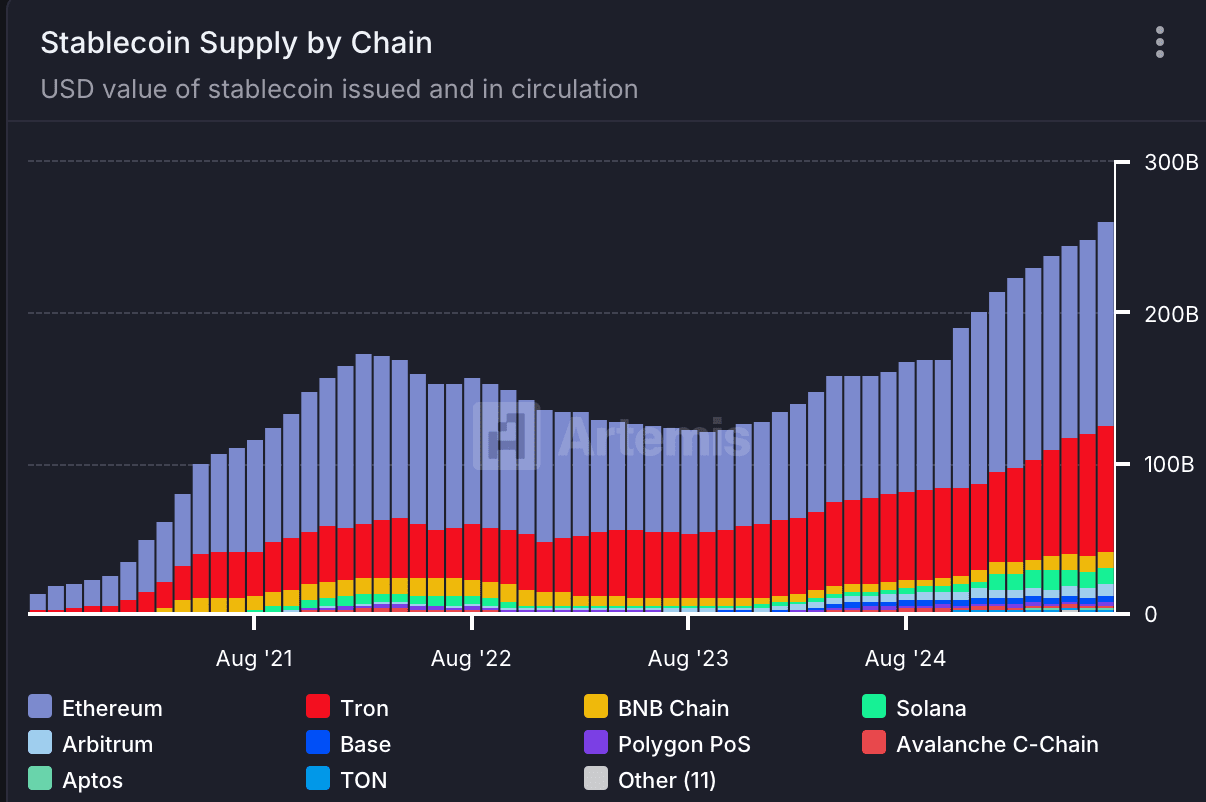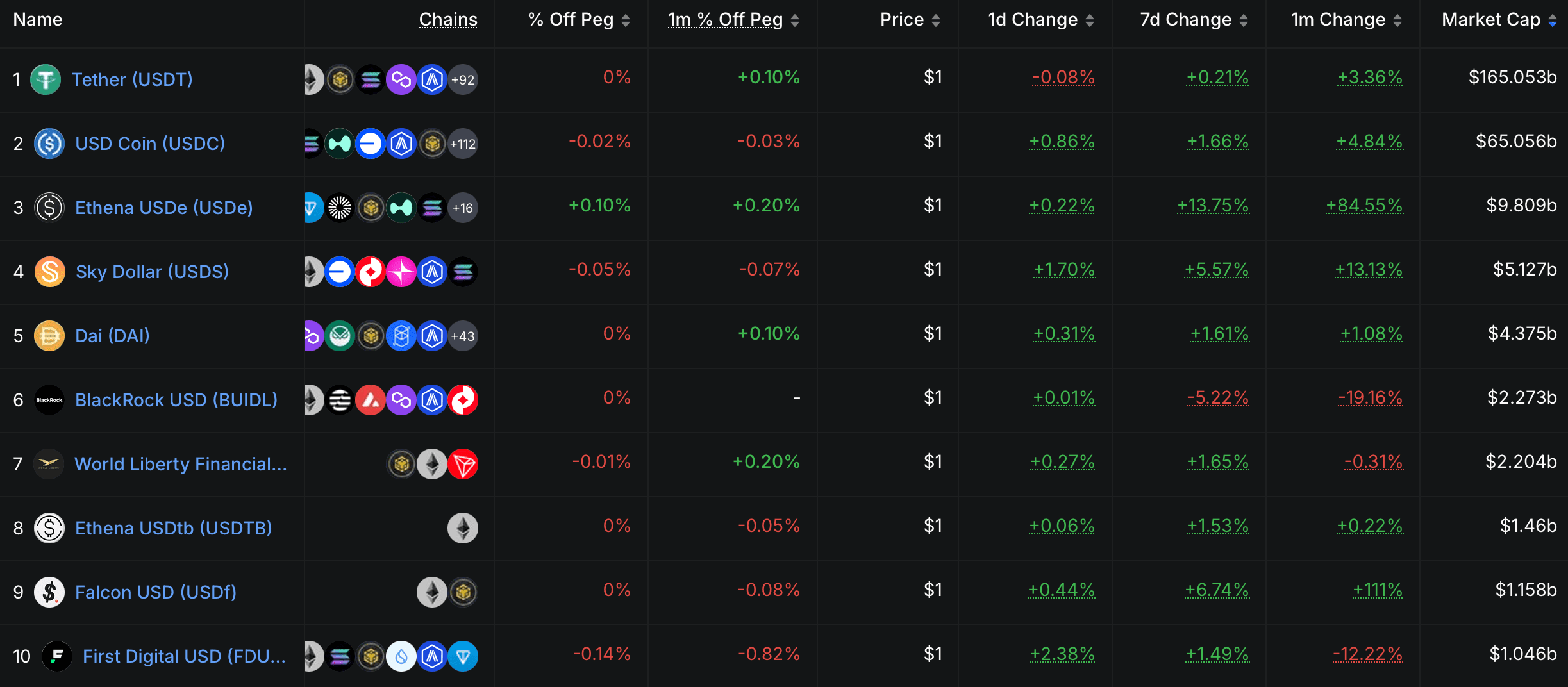The total value of the stablecoin market has surpassed $270 billion, marking a new milestone for the sector. The Stablecoin Economy Grows as Activity Expands.
In the past seven days, the aggregate market capitalization of stablecoins has increased by $3.051 billion, equivalent to a 1.14% increase, according to the defillama dashboard. The total new value brings this asset class back near its previous peak and continues a steady upward trend extending through 2024 and 2025. This figure reflects circulating supply multiplied by price and focuses on dollar-linked tokens.
Currently, tether (USDT) remains the market leader with a dominant share of 61.06%. USDC is the second-largest component, while competitors like Ethena's USDe, Sky's USDS, DAI, and Blackrock's BUIDL contribute smaller shares. Artemis Terminal's market share chart shows USDT increasing in 2025, and USDC's share is trending upward this year.

Activity remains widespread. Artemis reports that 42.8 million addresses interacted with stablecoins last month, down 15.2% from 30 days prior, but still close to a five-year high. On-chain address activity has expanded, with notable participation on BNB Chain, Tron, Base, Arbitrum, Solana, and OP Mainnet alongside Ethereum.
Heavy trading volume. Data from Artemis estimates $2.7 trillion in adjusted stable transfer volume over the past 30 days, despite a 11.19% decrease from the previous month. The terminal's multi-year outlook indicates that adjusted volume is fluctuating around $1 trillion throughout 2024–2025, generally near the level of Visa and much higher than the total of Paypal and global remittances on an equivalent basis.

The number of transactions remains high at 1.3 billion over the past 30 days, down 23.55% from the previous period. That total spans across major networks and indicates frequent use for payment, settlement, trading, and wallet funding activities on centralized and on-chain venues.
Supply composition is heavily concentrated on the US dollar. Artemis's currency analysis shows that issuance is primarily in USD, with the euro, British pound, and other fiat currencies making up a very small portion of the aggregate supply. The US dollar continues to play a central role in pricing and collateral practices on major exchanges and lending platforms.
Key Chain. Artemis's on-chain supply chart shows that Ethereum and Tron hold the largest outstanding balances to date, followed by BNB Chain, Solana, Base, and Arbitrum. The five-year outlook on net supply change ranks Ethereum first in absolute growth, with Tron second. The increase in contributions from Base and Solana highlights additional venues for issuance and circulation.

By token, the five-year net change table places USDT far ahead in additional supply, with USDC next. USDe and USDS contribute small but notable increases, while DAI and BUIDL add small increments. This mix suggests that current issuers remain dominant, even as new instruments targeting on-chain cash management or delta-neutral yield strategies emerge.
Regional flow is diverse. Using a timezone-based method on Ethereum and Solana, Artemis identifies a significant portion of transactions adjusting for North America and Asia, with Europe's share increasing from 2024. Latin America, Southeast Asia, and Africa account for smaller but very visible shares, marking acceptance from both individual and institutional users.
The active address chart by token highlights USDT and USDC as the main drivers, with the number of addresses and interactions reaching new highs in 2025. Smaller issuers, including PYUSD and other stablecoins, have limited but steady interactions. The expansion of the participant base indicates the role of stablecoins as a gateway to cryptocurrency and a payment intermediary.
Data from defillama.com and Artemis Terminal both indicate a larger system, operating robustly and geographically distributed. The headline figure of $270.303 billion closes a continuous expansion phase, while liquidity is concentrated among a few issuers and blockchain networks. This type of asset acts as a bridge between trading venues, wallets, and traditional finance, including both centralized exchanges and on-chain protocols.

When the total amount exceeds $270 billion, liquidity conditions on exchanges and in decentralized finance (DeFi) remain closely related to dollar-linked assets. The rhythm from month to month varies, but the combination of dominant issuers, multi-chain distribution, and deep address activity indicates sustainable demand for cryptocurrency dollars across trading, remittances, and payments.
To clarify, Defillama lists the history of total stablecoin market capitalization from below $10 billion in 2019 to above $250 billion by the end of 2021, followed by a decrease and gradual recovery by 2025. Today's reading of $270.303 billion places the amount at a new high for this period.


